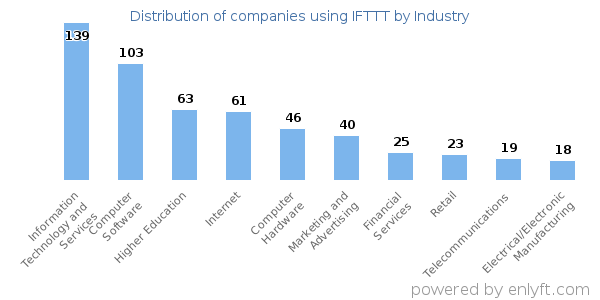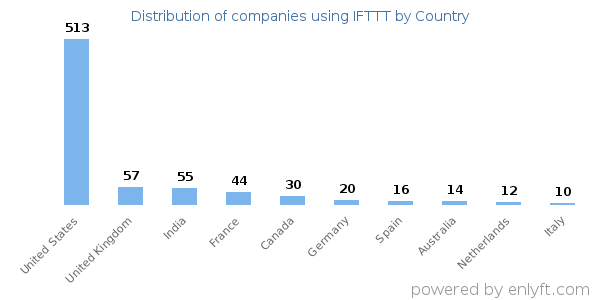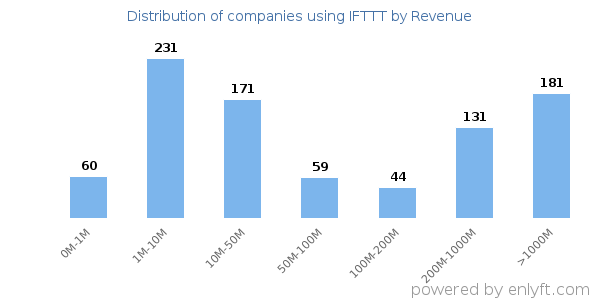Companies using IFTTT
We have data on 836 companies that use IFTTT. The companies using IFTTT are most often found in United States and in the Information Technology and Services industry. IFTTT is most often used by companies with 10-50 employees and 1M-10M dollars in revenue. Our data for IFTTT usage goes back as far as 5 years and 6 months.
Who uses IFTTT?
| Company | Axosoft |
| Website | axosoft.com |
| Country | United States |
| Revenue | 10M-50M |
| Company Size | 50-200 |
| Company | Accenture PLC |
| Website | accenture.com |
| Country | Ireland |
| Revenue | >1000M |
| Company Size | >10000 |
| Company | Cognizant Technology Solutions Corp |
| Website | cognizant.com |
| Country | United States |
| Revenue | >1000M |
| Company Size | >10000 |
| Company | Infosys Ltd |
| Website | infosys.com |
| Country | India |
| Revenue | >1000M |
| Company Size | >10000 |
| Company | Udemy |
| Website | udemy.com |
| Country | United States |
| Revenue | 200M-1000M |
| Company Size | 1000-5000 |
| Company | Website | Country | Revenue | Company Size |
|---|---|---|---|---|
| Axosoft | axosoft.com | United States | 10M-50M | 50-200 |
| Accenture PLC | accenture.com | Ireland | >1000M | >10000 |
| Cognizant Technology Solutions Corp | cognizant.com | United States | >1000M | >10000 |
| Infosys Ltd | infosys.com | India | >1000M | >10000 |
| Udemy | udemy.com | United States | 200M-1000M | 1000-5000 |
Target IFTTT customers to accomplish your sales and marketing goals.
IFTTT Market Share and Competitors in Programming Languages
We use the best indexing techniques combined with advanced data science to monitor the market share of over 15,000 technology products, including Programming Languages. By scanning billions of public documents, we are able to collect deep insights on every company, with over 100 data fields per company at an average. In the Programming Languages category, IFTTT has a market share of about 0.1%. Other major and competing products in this category include:
Programming Languages


What is IFTTT?
If This Then That, also known as IFTTT, is a free web-based service to create chains of simple conditional statements, called applets. An applet is triggered by changes that occur within other web services such as Gmail, Facebook, Telegram, Instagram, or Pinterest.
Top Industries that use IFTTT
Looking at IFTTT customers by industry, we find that Information Technology and Services (13%), Computer Software (11%), Internet (7%) and Higher Education (7%) are the largest segments.

Top Countries that use IFTTT
55% of IFTTT customers are in United States, 7% are in United Kingdom and 6% are in India.

Distribution of companies that use IFTTT based on company size (Employees)
Of all the customers that are using IFTTT, 36% are small (<50 employees), 31% are medium-sized and 32% are large (>1000 employees).

Distribution of companies that use IFTTT based on company size (Revenue)
Of all the customers that are using IFTTT, a majority (54%) are small (<$50M), 32% are large (>$1000M) and 7% are medium-sized.









